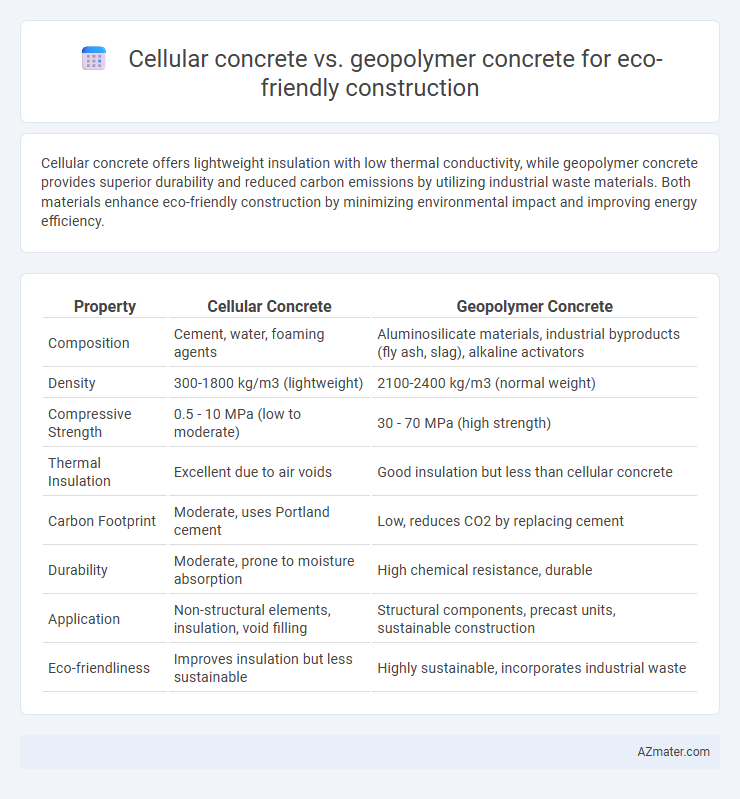Cellular concrete offers lightweight insulation with low thermal conductivity, while geopolymer concrete provides superior durability and reduced carbon emissions by utilizing industrial waste materials. Both materials enhance eco-friendly construction by minimizing environmental impact and improving energy efficiency.
Table of Comparison
| Property | Cellular Concrete | Geopolymer Concrete |
|---|---|---|
| Composition | Cement, water, foaming agents | Aluminosilicate materials, industrial byproducts (fly ash, slag), alkaline activators |
| Density | 300-1800 kg/m3 (lightweight) | 2100-2400 kg/m3 (normal weight) |
| Compressive Strength | 0.5 - 10 MPa (low to moderate) | 30 - 70 MPa (high strength) |
| Thermal Insulation | Excellent due to air voids | Good insulation but less than cellular concrete |
| Carbon Footprint | Moderate, uses Portland cement | Low, reduces CO2 by replacing cement |
| Durability | Moderate, prone to moisture absorption | High chemical resistance, durable |
| Application | Non-structural elements, insulation, void filling | Structural components, precast units, sustainable construction |
| Eco-friendliness | Improves insulation but less sustainable | Highly sustainable, incorporates industrial waste |
Introduction to Eco-Friendly Construction Materials
Cellular concrete and geopolymer concrete stand out as sustainable alternatives in eco-friendly construction, offering reduced carbon footprints compared to traditional Portland cement. Cellular concrete incorporates air bubbles, enhancing insulation and reducing material usage, while geopolymer concrete uses industrial by-products like fly ash or slag, minimizing greenhouse gas emissions. These innovative materials contribute to energy efficiency and resource conservation, supporting greener building practices.
Cellular Concrete: Composition and Properties
Cellular concrete is a lightweight material composed of cement, water, and pre-formed foam that creates air voids, significantly reducing its density compared to traditional concrete. Its high thermal insulation, fire resistance, and sound absorption properties make it ideal for eco-friendly construction applications, minimizing energy consumption. The porous structure also enhances durability and reduces environmental impact by utilizing fewer raw materials and decreasing overall carbon footprint.
Geopolymer Concrete: Composition and Properties
Geopolymer concrete is composed of aluminosilicate materials like fly ash or slag activated by alkaline solutions, resulting in a low-carbon alternative to traditional Portland cement. Its properties include high thermal stability, excellent chemical resistance, and superior compressive strength, making it suitable for sustainable construction projects. The use of industrial by-products in geopolymer concrete significantly reduces greenhouse gas emissions and energy consumption compared to cellular concrete.
Sustainability and Environmental Impact Comparison
Cellular concrete offers lightweight, thermal insulation benefits with lower density reducing resource consumption, while geopolymer concrete utilizes industrial byproducts like fly ash to significantly lower CO2 emissions compared to traditional Portland cement. Geopolymer concrete exhibits higher durability and chemical resistance, extending structural lifespan and reducing maintenance-related environmental costs. Both materials promote sustainability by minimizing raw material extraction and enhancing energy efficiency, yet geopolymer concrete's reduced carbon footprint positions it as a more environmentally impactful solution for eco-friendly construction.
Strength and Durability Analysis
Cellular concrete exhibits lower compressive strength ranging between 2 to 15 MPa, making it suitable for non-load-bearing eco-friendly applications, whereas geopolymer concrete demonstrates superior strength often exceeding 40 MPa due to its aluminosilicate binder composition. Durability analysis reveals geopolymer concrete's enhanced resistance to chemical attack, high temperatures, and freeze-thaw cycles compared to cellular concrete, which is more susceptible to moisture ingress and thermal degradation. The sustainability of geopolymer concrete is further elevated by its utilization of industrial by-products like fly ash, contributing to both environmental benefits and long-term performance in green construction projects.
Thermal and Acoustic Insulation Performance
Cellular concrete offers excellent thermal insulation due to its porous structure, significantly reducing heat transfer and energy consumption in buildings. Geopolymer concrete provides superior acoustic insulation by incorporating dense, inorganic binders that dampen sound transmission effectively. Both materials contribute to eco-friendly construction by enhancing energy efficiency and indoor comfort through their distinct insulation properties.
Workability and Construction Methods
Cellular concrete offers superior workability due to its lightweight, flowable mixture that allows easy placement and reduces labor effort, while geopolymer concrete requires careful mixing and curing to achieve optimal performance, often involving more specialized construction techniques. The air-entrained nature of cellular concrete facilitates rapid application and minimal formwork, enhancing construction speed and adaptability on-site. Geopolymer concrete's alkali-based chemistry demands controlled conditions and skilled application methods to ensure durability and eco-friendliness, making it more suitable for precast or controlled environment construction.
Cost-Effectiveness and Availability
Cellular concrete offers cost-effective advantages due to its lightweight composition and use of industrial by-products, reducing material expenses and transportation costs. Geopolymer concrete, derived from abundant industrial waste like fly ash and slag, provides enhanced durability and thermal resistance, often resulting in lower lifecycle costs despite higher initial prices. Both materials promote eco-friendly construction, but cellular concrete's widespread raw material availability can make it more accessible for budget-conscious projects.
Applications in Green Building Projects
Cellular concrete, known for its lightweight and excellent thermal insulation properties, is widely used in green building projects for non-load-bearing walls, roof insulation, and void filling to enhance energy efficiency. Geopolymer concrete, derived from industrial by-products like fly ash and slag, offers superior durability and reduced carbon footprint, making it ideal for structural elements in sustainable construction. Both materials contribute to eco-friendly construction by minimizing environmental impact while meeting the functional demands of modern green buildings.
Future Trends in Sustainable Construction Materials
Cellular concrete and geopolymer concrete represent future trends in sustainable construction by significantly reducing carbon footprints through lower cement usage and enhanced thermal insulation properties. Geopolymer concrete utilizes industrial by-products like fly ash and slag, offering superior durability and reduced greenhouse gas emissions compared to traditional Portland cement, while cellular concrete incorporates lightweight aggregates and air voids to improve energy efficiency in buildings. Advances in nanotechnology and binder chemistry are expected to further optimize these materials' performance, promoting widespread adoption in green building certifications and eco-friendly infrastructure projects.

Infographic: Cellular concrete vs Geopolymer concrete for Eco-friendly construction
 azmater.com
azmater.com